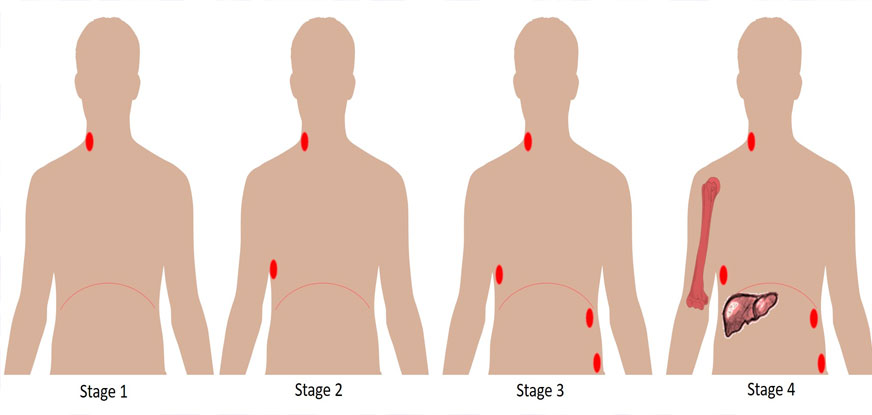Overview
When the lymph nodes start to multiply uncontrollably and produce poisonous cells, affecting the tissues throughout the body, we say the person is suffering from Lymphoma. Another name for it is disease.
Hodgkin’s Lymphoma is a type of cancer that occurs in the lymphatic system. The lymphatic system is a vast web of nodes which is linked with vessels that help in draining fluid and waste products from the body. It is responsible for acting as small filters to strain out foreign organisms and cells. One of the significant roles of the lymphatic system is to produce white blood cells which are called lymphocytes, which are responsible for fighting various infections caused by bacteria, fungi and viruses.
Lymphoma: Signs and Symptoms
In Lymphoma, one may observe:
- Swelling (painless) in one or more lymph nodes without any infection
- Shortness of breath, cough, abdominal swelling or pain, swelling in legs and nerve pain
- Horner’s syndrome which is a neurological problem that affects the face and eyes
- Fever in the late afternoon or early evening for 14 days or longer. The temperature would usually go above 102 degrees Fahrenheit, twice in a day
- Discomforting pain in the abdomen area, especially after consuming alcohol
- Heavy sweating or extreme chills during nights for 14 days or more
- Unexplained weight loss
- Pain in bones
- Vulnerability to infections and body itching
Lymphoma: Causes
Medical science has still not found the exact reason on the causes of Lymphoma. But, there are some of them which have been commonly seen in a patient suffering from the same. They are:
- Viruses - There is a type of virus which has also been found out to be the cause of infectious mononucleosis. It is known as Epstein-Barr virus. It has been observed that the genome of this virus is present in 20%-80% of Lymphoma tumors.
- Familial - Lymphoma has also been observed in families where there are same-sex siblings or an identical twin of a person with the same tumor. Even if one of the parents has this tumor, the child is likely to have it.
Various other factors cause Lymphoma, like having fewer siblings, single-family homes or early birth order. People who are not exposed much to bacterial and viral infections also face this problem.
What Are the Different Types of Lymphoma?
There are four types of Lymphoma, each having a common factor, i.e. Reed-Sternberg Cells. They are the following:
- Nodular Sclerosis HL - Nodular Sclerosis is one type of Lymphoma that is the most common among patients, accounting for 60%-80% of the cases. Mostly diagnosed at the second stage, Nodular Sclerosis starts to occur in the chest, lymph nodes or neck. Usually, it occurs in teenagers and adults with an age group of 15-35. Also, the percentage of men and women facing this disease is the same.
- Mixed Cellularity HL - After Nodular Sclerosis HL, mixed cellularity HL is the type of Lymphoma that is observed the most in patients. It usually occurs in older adults and that too in people with HIV infection. Mixed cellularity HL can also start with the lymph node, further spreading its roots to the upper half of the body. It is seen that it often affects the lymph nodes in the abdomen and spleen.
- Lymphocyte-rich Classic HL - Lymphocyte-rich classic HL is found to be there only in 5% of the cases. Unlike Nodular Sclerosis, it is seen more often in men and that too in older ones. Lymphocyte-rich classic HL is most commonly found at an early stage, displaying its symptoms in areas like armpits, lymph nodes in the neck and above the collarbone.
- Lymphocyte-depleted HL - Accounting for only 1% of all cases of Lymphoma, Lymphocyte-depleted HL is common in older people and mostly in men with HIV infection. It affects areas like lymph nodes in the spleen and abdomen, liver and bone marrow.
Lymphoma: Treatment
There are various factors by which treatment is done for Lymphoma. Type and location of the lymphoma are considered to be the most critical factors in determining the type of treatment. Following are the ways in which Lymphoma can be treated:
- Chemotherapy - One of the most common treatments for Lymphoma is Chemotherapy. In this treatment, drugs are injected into the veins. These chemo drugs run throughout the body, destroying cancer cells. During chemotherapy, a patient experiences hair loss, nausea, loss of appetite and fatigue. Typically, these side effects fade away after the treatment is finished.
- Radiation Therapy - In Radiation therapy, high-energy rays are used to destroy cancer cells. It is also used as a common treatment for lymphoma. But, it is more efficient when Hodgkin Lymphoma is only in one part of the body.
- Immunotherapy - Immunotherapy uses various medicines to vitalize the immune system of the patient, enabling it to recognize the cancer cells and destroy it.
- Stem Cell Transplant - Stem Cell Transplants (SCTs) is done in cases when chemotherapy and radiation therapy fails to treat Lymphoma. In SCTs, doctors give a high dosage of chemo and radiation therapy because once the patient gets high-dose, to restore the bone marrow; the patient receives a transplant of blood-forming stem cells.
Life after Lymphoma
Living as a Lymphoma survivor can be a little tiring as you would have to go for regular follow-ups. Like other cancers, recurrence of Lymphoma can be expected even after years of treatment. Therefore, it is crucial for you and your doctor to keep a close check on your health.
Follow-up Care after Lymphoma Treatment
Like other tumors, Lymphoma also requires timely check-ups to be performed for there are a lot of chances for its recurrence. After completing all the treatments, a patient may face long-term health issues such as leukemia, infertility, breast cancer, thyroid disease, lung cancer, heart disease, lung disease and myelodysplastic syndrome.


